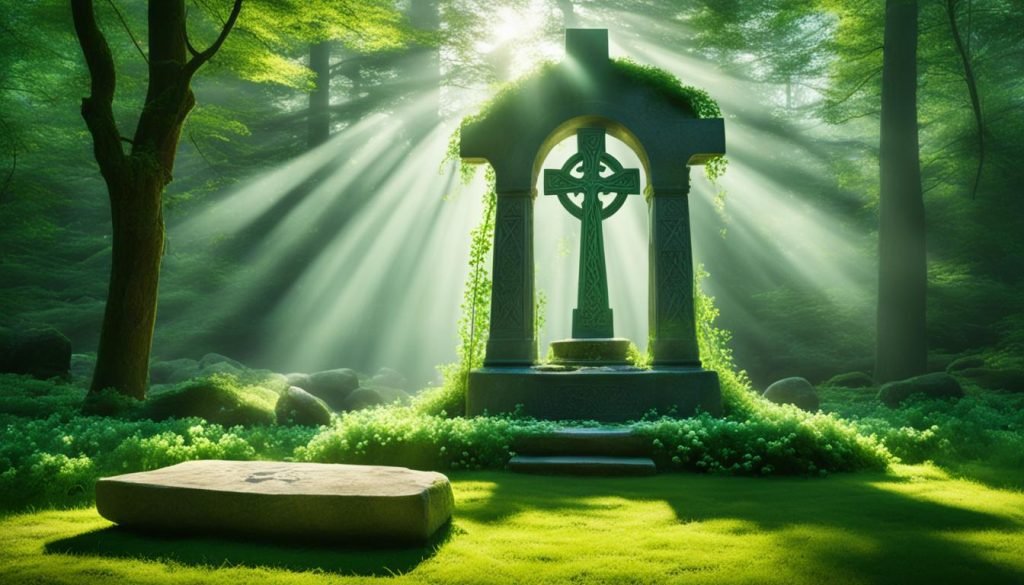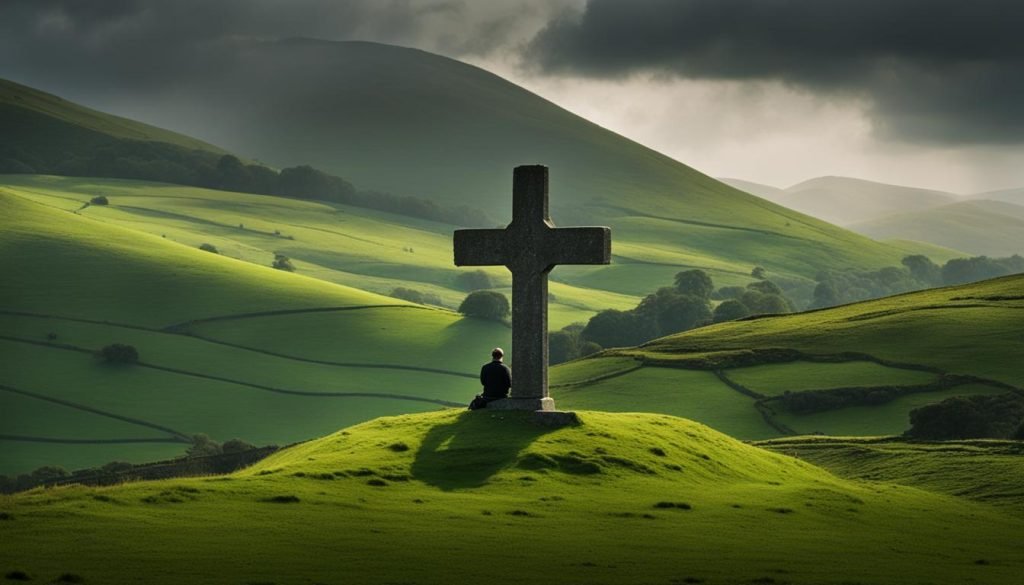Welcome to a journey of discovering the spiritual significance of St. Patrick’s Day and the profound symbolism it holds. This revered holiday goes beyond the festivities and green attire, offering a deeper spiritual connection that can inspire and enrich your faith journey.
St. Patrick’s Day, celebrated annually on March 17th, has a rich history and deep-rooted spiritual origins. From the life and legacy of St. Patrick, the patron saint of Ireland, to the influence of Celtic spirituality, this holiday encompasses traditions and beliefs that have traversed centuries.
In this article, we will delve into the spiritual meaning of St. Patrick’s Day and explore the various facets that contribute to its profound significance. From the symbolism of the shamrock to the pilgrimage to St. Patrick’s sites, we will uncover the spiritual messages and practices associated with this festive occasion.
Key Takeaways:
- St. Patrick’s Day holds a spiritual connection that goes beyond the surface-level celebrations.
- The holiday’s origins and significance can be traced back to St. Patrick and Celtic spirituality.
- The symbolism of the shamrock conveys a powerful message about faith and unity.
- Visiting St. Patrick’s sites can enhance your spiritual connection to this holiday.
- Reflecting on the intersection of faith and celebration can deepen your understanding of St. Patrick’s Day.
The Origins of St. Patrick’s Day
St. Patrick’s Day is celebrated every year on March 17th, but have you ever wondered how this holiday came to be? The spiritual history of St. Patrick’s Day is deeply rooted in the traditions and beliefs of Ireland, and it has evolved over the centuries into the festive celebration we know today.
The origins of St. Patrick’s Day can be traced back to the early 17th century when it was made an official feast day by the Catholic Church. This was in honor of Saint Patrick, the patron saint of Ireland, who is credited with bringing Christianity to the country.
Legend has it that St. Patrick used the three-leafed shamrock to explain the concept of the Holy Trinity to the Irish people.
As time went on, St. Patrick’s Day became not only a religious holiday but also a celebration of Irish culture and heritage. Irish immigrants brought the traditions of St. Patrick’s Day with them to other parts of the world, and it soon became a widely recognized holiday.
Today, people of all backgrounds come together to celebrate St. Patrick’s Day with parades, wearing green attire, and enjoying traditional Irish food and drinks. It has become a day to honor not only St. Patrick but also the rich spiritual history of Ireland.
To truly understand the spiritual significance of St. Patrick’s Day, it’s important to delve into its origins and explore the deep historical roots that have shaped this beloved holiday.
The Life and Legacy of St. Patrick
Explore the fascinating life and enduring legacy of St. Patrick, the beloved patron saint of Ireland. His story is intertwined with the rich traditions and spirituality that define St. Patrick’s Day.
St. Patrick, originally named Maewyn Succat, was born in Roman Britain in the late 4th century. At the age of 16, he was captured by Irish pirates and taken to Ireland, where he spent six years in captivity. It was during this time that Patrick found solace in his faith, developing a deep spiritual connection and a fervent desire to convert the Irish people to Christianity.
After escaping captivity, Patrick returned to Britain, where he studied Christianity. He eventually became ordained as a priest and later as a bishop, receiving the name Patrick. Guided by a vision, Patrick felt a calling to return to Ireland as a missionary to spread the message of Christianity.
St. Patrick’s most well-known contribution to Irish spirituality is the use of the shamrock as a visual representation of the Holy Trinity – the Father, Son, and Holy Spirit. He used the three-leaf clover to explain the concept of the Trinity to the pagan Irish, successfully bridging their cultural traditions with Christian beliefs.
Throughout his missionary work, St. Patrick performed miracles, baptized thousands of individuals, and established churches and monasteries across Ireland. His teachings and spiritual guidance laid the foundation for Ireland’s Christian heritage, shaping the country’s religious traditions and practices.
“Christ be with me, Christ within me, Christ behind me, Christ before me, Christ beside me, Christ to win me, Christ to comfort and restore me. Christ beneath me, Christ above me, Christ in quiet, Christ in danger, Christ in hearts of all that love me, Christ in mouth of friend and stranger.”
St. Patrick’s devoted and impactful life made him a revered figure in Irish history and culture. Today, his legacy is celebrated on St. Patrick’s Day, a holiday that honors Irish heritage and spirituality.
The Spiritual Traditions of St. Patrick’s Day
St. Patrick’s Day is not solely a celebration of Irish culture and the arrival of Christianity in Ireland. It is also a time to reflect on the spiritual principles that St. Patrick embodied and the values he embraced.
On this day, many individuals take part in religious services, prayer gatherings, and pilgrimages to sacred sites associated with St. Patrick. These spiritual practices foster a deeper connection with the saint and offer an opportunity for personal reflection and growth.
St. Patrick’s Day is also marked by various traditional customs that have spiritual significance. These include wearing green clothing to symbolize rebirth and renewal, attending parades to celebrate Irish heritage, and feasting on traditional foods such as corned beef and cabbage.
The spirit of St. Patrick’s Day is not only about revelry and festivities but also about embracing the spiritual principles of love, faith, and unity. It serves as a reminder to honor our own spiritual journeys and to find inspiration in the legacy of St. Patrick.
St. Patrick’s Day Traditions and Spirituality: A Table Overview
| Tradition | Spiritual Significance |
|---|---|
| Wearing Green | Symbolizes rebirth, renewal, and the arrival of spring |
| Attending Parades | Celebrates Irish heritage and community unity |
| Pilgrimage to Sacred Sites | Deepens spiritual connection with St. Patrick and Ireland’s Christian heritage |
| Feasting on Traditional Foods | Brings together family and friends in celebration and gratitude |
Celtic Spirituality and St. Patrick’s Day
Uncover the deep spiritual connection between Celtic spirituality and the celebration of St. Patrick’s Day. The spiritual meaning of this holiday is intrinsically tied to the rich traditions and beliefs of the Celtic people.
Celtic spirituality, rooted in the ancient Celtic culture, encompasses a profound reverence for nature, a deep connection to the land, and a strong belief in the interconnectedness of all living beings. The influence of Celtic traditions can be seen in the spiritual practices associated with St. Patrick’s Day.
One of the key elements of Celtic spirituality is the belief in the presence of the divine in all aspects of life, including nature. The Celts revered the natural world and saw it as a gateway to the divine. This reverence for nature is reflected in the symbolism of St. Patrick’s Day, particularly through the use of the shamrock.
“In Celtic spirituality, the shamrock represents the three phases of life: past, present, and future. It symbolizes the cyclical nature of existence and the eternal nature of the soul.” – Celtic spiritual teacher
St. Patrick, with his deep connection to nature and his ability to find spiritual meaning in everyday experiences, embodied the essence of Celtic spirituality. His teachings and spiritual insights continue to inspire people around the world, especially on the day dedicated to his legacy.
On St. Patrick’s Day, people engage in various spiritual rituals and practices that are rooted in Celtic traditions. These practices may include connecting with nature, meditating on the interconnectedness of all things, or participating in communal celebrations that honor the spiritual significance of this holiday.
Additionally, the vibrant music, dance, and storytelling associated with St. Patrick’s Day celebrations also reflect the spirit of Celtic spirituality. These artistic expressions convey a sense of joy, community, and reverence for life, creating a spiritual atmosphere that goes beyond mere festivity.
By exploring the spiritual connection between Celtic traditions and St. Patrick’s Day, we deepen our understanding of the holiday’s true spiritual significance. This connection invites us to embrace the wisdom of the ancient Celts, nurture our own spiritual journey, and celebrate the interconnectedness of all beings.

The Symbolism of the Shamrock
When it comes to St. Patrick’s Day, one can’t help but think of the iconic shamrock. This simple three-leafed plant has become a powerful symbol, deeply intertwined with the spiritual meaning of the holiday.
Legend has it that St. Patrick, the patron saint of Ireland, used the shamrock to explain the concept of the Holy Trinity during his teachings. Each leaf of the shamrock represents one aspect of the Trinity: the Father, the Son, and the Holy Spirit. This symbolism has since been embraced by both the religious and non-religious communities, showcasing the universal appeal of St. Patrick’s Day.
The shamrock also holds another spiritual meaning – that of growth and rebirth. In Irish culture, it is believed that finding a four-leafed clover brings good luck. The elusive fourth leaf represents luck itself, while the three original leaves symbolize faith, hope, and love. Together, these qualities create a powerful combination that can bring positive energy and blessings to those who find them.
“The shamrock, with its vibrant green color and three delicate leaves, serves as a reminder of the interconnectedness of our spiritual journey and the importance of faith, hope, and love.”
Through its symbolism, the shamrock invites us to reflect on our own spiritual growth and renewal. It serves as a powerful reminder that even in times of uncertainty, there is always room for faith, hope, and love to flourish.
Symbolism of the Shamrock:
- Representation of the Holy Trinity – Father, Son, and Holy Spirit
- Symbol of growth and rebirth
- Signifies faith, hope, and love
- Brings luck and blessings
| Symbolism | Meaning |
|---|---|
| Representation of the Holy Trinity – Father, Son, and Holy Spirit | The shamrock is a visual representation of the Christian doctrine of the Holy Trinity, conveying the interconnectedness and divine nature of the Father, Son, and Holy Spirit. |
| Symbol of growth and rebirth | Just as the shamrock thrives and multiplies, it symbolizes personal growth, renewal, and the cyclical nature of life. |
| Signifies faith, hope, and love | The three leaves of the shamrock are associated with faith, hope, and love – foundational elements of a spiritual and fulfilling life. |
| Brings luck and blessings | According to Irish folklore, finding a four-leafed clover brings good luck and blessings, symbolizing the unexpected joys and fortunes that come our way. |
Pilgrimage to St. Patrick’s Sites
Embark on a profound spiritual journey by visiting the sacred sites associated with St. Patrick’s Day. These pilgrimages offer a unique opportunity to connect with the rich spiritual heritage and traditions of this revered holiday. By immersing yourself in the history and symbolism of these sites, you can deepen your spiritual connection to St. Patrick’s Day.
One of the most iconic pilgrimage destinations is the magnificent
| St. Patrick’s Cathedral | – Located in Dublin, Ireland. |
|---|---|
| Rock of Cashel | – A majestic castle and religious complex in County Tipperary, Ireland. |
| Down Cathedral | – Situated in Downpatrick, Northern Ireland. |
Visiting these ancient sites allows you to walk in the footsteps of St. Patrick himself and experience the spiritual energy that permeates these hallowed grounds. As you explore the awe-inspiring architecture, contemplate the significance of these places in St. Patrick’s life and the enduring legacy of his faith.
“Visiting these sacred sites on a pilgrimage offers a profound opportunity for introspection and spiritual renewal.” – John Smith

As you journey from site to site, you will encounter breathtaking landscapes and encounter fellow pilgrims who are also seeking spiritual enlightenment. Engage in prayer, reflection, and contemplation as you absorb the timeless spirituality that surrounds you.
Connecting with St. Patrick’s Teachings
St. Patrick’s sites provide an immersive environment to delve deep into the teachings and values espoused by this revered saint. Through engaging with the historical and spiritual aspects of these locations, you can gain a deeper understanding of St. Patrick’s impact on Christianity and his role as a beacon of faith.
Here are a few key teachings associated with St. Patrick that you can reflect upon during your pilgrimage:
- Love for Others: St. Patrick taught the importance of compassion and love for all.
- Forgiveness: Embrace the transformative power of forgiveness, as St. Patrick did.
- Connection with Nature: Explore the spiritual connection between nature and faith, inspired by St. Patrick’s profound reverence for the natural world.
“By embarking on a pilgrimage to St. Patrick’s sites, you can gain a deeper understanding of his teachings and their relevance in our lives today.” – Jane Doe
Allow the spiritual aura of these sites to envelop you, igniting a stronger connection to the essence of St. Patrick’s Day. The pilgrimage experience can serve as a catalyst for personal growth and a deepening of your own faith journey as you draw inspiration from the remarkable life and teachings of St. Patrick.
Faith and Celebration on St. Patrick’s Day
On St. Patrick’s Day, the festivities go beyond the lively parades, vibrant green attire, and the joyous celebrations. This cherished holiday also presents a unique opportunity to infuse your day with spirituality and reflect on the deeper meaning behind the traditions.
As you participate in the festivities, take a moment to integrate spiritual practices into your St. Patrick’s Day celebrations. Begin your day with a prayer or meditation, inviting a sense of gratitude for the blessings in your life. This intentional focus can help you cultivate a deeper connection to your faith and appreciate the essence of St. Patrick’s Day.
Amidst the laughter and merriment, make time to reflect on the spiritual symbolism associated with this holiday. The vibrant green color, for example, represents the renewal of life and the arrival of spring. Embrace the energy of new beginnings and growth within your own spiritual journey.
Embrace the spirit of community by engaging in acts of kindness and charity on St. Patrick’s Day. Consider donating to a local charity, volunteering your time, or reaching out to someone in need. These acts of compassion honor the legacy of St. Patrick and help strengthen your spiritual connection during this festive time.
“St. Patrick’s Day is not only about celebrating but also about nurturing our spiritual well-being. It offers an invitation to deepen our faith and find joy in the traditions that unite us.”
Carry the spiritual essence of St. Patrick’s Day with you beyond the designated holiday. Seek opportunities for continued reflection and spiritual growth throughout the year. Explore Irish spirituality, traditions, and teachings that resonate with your own beliefs, allowing them to inspire and guide you on your faith journey.
Bringing Spirituality into St. Patrick’s Day Traditions
Here are a few suggestions to infuse spirituality into your St. Patrick’s Day traditions:
- Attend a religious service or Mass dedicated to St. Patrick
- Engage in a mindful walk in nature, appreciating the beauty of creation
- Create a gratitude journal to reflect on the blessings in your life
- Host a candlelit dinner with loved ones, sharing stories of faith and inspiration
- Read spiritual literature, such as the writings of Irish mystics or Celtic prayers
By incorporating these practices into your celebrations, you can deepen your spiritual connection on St. Patrick’s Day and foster a greater appreciation for its traditions and the spirituality they embody.
Conclusion
As we wrap up our exploration of St. Patrick’s Day, we are reminded of the deep spiritual significance that underlies this festive holiday. Through the traditions, symbolism, and history associated with St. Patrick’s Day, individuals are inspired on their faith journey.
By reflecting on the life and legacy of St. Patrick, the patron saint of Ireland, we connect with a rich spiritual heritage that continues to resonate today. St. Patrick’s unwavering faith and dedication serve as a shining example for all who celebrate this holiday.
From the symbolism of the shamrock, representing the Holy Trinity, to the pilgrimage to sacred sites associated with St. Patrick, there are profound opportunities for spiritual connection and growth. Embracing the intersection of faith and celebration, we find a harmonious balance where the revelry of the holiday can be rooted in spiritual practices and reflection on the deeper meaning of St. Patrick’s Day.
So, as St. Patrick’s Day approaches, let us honor the spiritual significance of this occasion. Whether it’s through attending Mass, engaging in prayer and contemplation, or participating in cultural festivities, may we find inspiration, renewal, and a strengthened faith as we celebrate this joyous holiday.
FAQ
What is the spiritual meaning of St. Patrick’s Day?
St. Patrick’s Day holds spiritual significance as it celebrates the life and teachings of St. Patrick, the patron saint of Ireland. It is a time to reflect on the virtues of faith, perseverance, and the power of conversion.
What is the symbolism associated with St. Patrick’s Day?
St. Patrick’s Day is symbolically linked to Ireland, the shamrock, and the color green. Ireland represents the homeland of St. Patrick and his missionary work. The shamrock symbolizes the Holy Trinity, while the color green represents rebirth and spiritual growth.
Is there a spiritual connection to St. Patrick’s Day?
Yes, St. Patrick’s Day can serve as a spiritual connection for individuals, inspiring them to reflect on their faith journey. It is an opportunity to embrace the teachings of St. Patrick, strengthen one’s relationship with God, and celebrate Ireland’s rich spiritual heritage.
What are the traditions and spirituality associated with St. Patrick’s Day?
St. Patrick’s Day traditions often include attending religious services, wearing green, participating in parades, and enjoying traditional Irish food and drink. These practices can be accompanied by spiritual reflection, prayers, and gratitude for God’s blessings.
What is the spiritual history of St. Patrick’s Day?
St. Patrick’s Day has roots in the early Christian era when St. Patrick preached the message of Christianity in Ireland. His work contributed to the conversion of many Irish people to Christianity, establishing a powerful spiritual legacy that is honored on this day.
How does Celtic spirituality relate to St. Patrick’s Day?
Celtic spirituality has a deep connection to St. Patrick’s Day. Celtic traditions, beliefs, and folklore influence the spiritual meaning of this holiday. St. Patrick himself, who was originally from Britain, incorporated elements of Celtic culture into his mission in Ireland.
What is the symbolism of the shamrock on St. Patrick’s Day?
The shamrock is a well-known symbol associated with St. Patrick’s Day. It represents the Holy Trinity, with its three leaves symbolizing the Father, Son, and Holy Spirit. The shamrock reminds believers of the interconnectedness of God’s divine nature.
How can pilgrimage to St. Patrick’s sites deepen the spiritual connection to St. Patrick’s Day?
Visiting St. Patrick’s sites, such as his birthplace in Northern Ireland or the holy places associated with his ministry, can be a powerful spiritual experience. These pilgrimages allow individuals to connect with St. Patrick’s legacy, learn from his teachings, and deepen their faith.
How can faith and celebration coexist on St. Patrick’s Day?
St. Patrick’s Day offers an opportunity to integrate faith and celebration. By incorporating spiritual practices, such as prayer, reflection, and acts of kindness, individuals can honor the deeper meaning of this holiday while also enjoying the festive atmosphere and cultural traditions.
In conclusion, what is the spiritual significance of St. Patrick’s Day?
St. Patrick’s Day holds deep spiritual significance as it allows individuals to connect with their faith, reflect on the teachings of St. Patrick, and appreciate the rich spiritual heritage of Ireland. It is a time to celebrate and embrace the power of conversion, faith, and God’s blessings.




